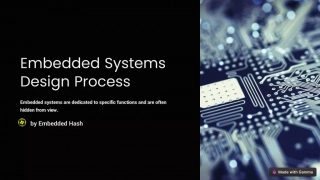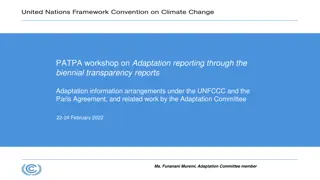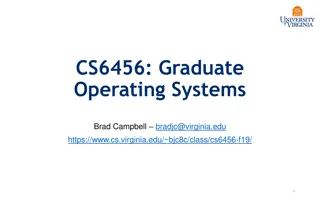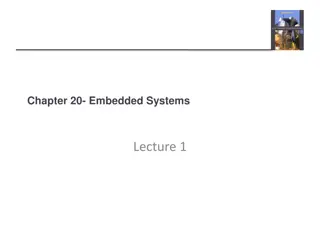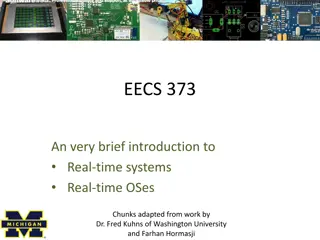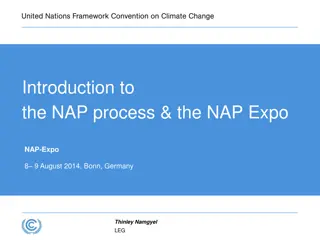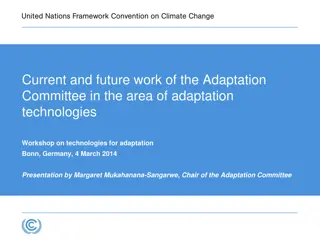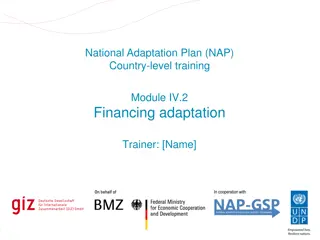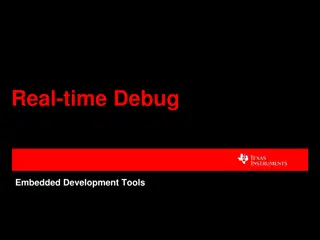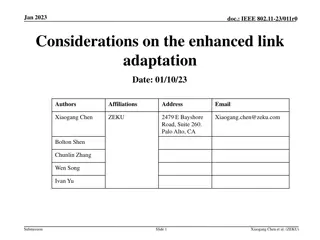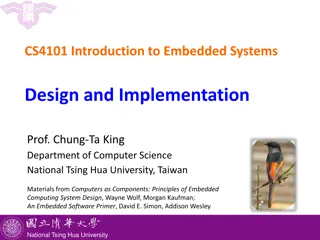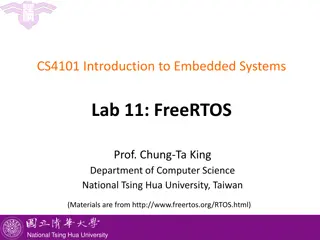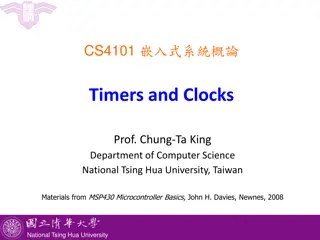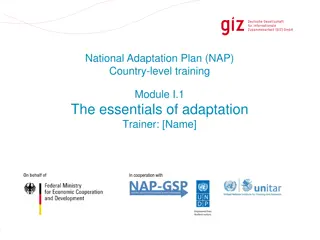Task Adaptation in Real-Time Embedded Systems
Examining the tradeoffs between energy consumption and reliability in real-time embedded systems, particularly focusing on intermittent faults and their impact on processor failures. Discusses the need to characterize intermittent errors and their effects on programs, as well as effective error tolerance techniques. Experimental setups using the SPEC2006 benchmark suite for fault simulations are explored.
Download Presentation

Please find below an Image/Link to download the presentation.
The content on the website is provided AS IS for your information and personal use only. It may not be sold, licensed, or shared on other websites without obtaining consent from the author.If you encounter any issues during the download, it is possible that the publisher has removed the file from their server.
You are allowed to download the files provided on this website for personal or commercial use, subject to the condition that they are used lawfully. All files are the property of their respective owners.
The content on the website is provided AS IS for your information and personal use only. It may not be sold, licensed, or shared on other websites without obtaining consent from the author.
E N D
Presentation Transcript
1 TASK ADAPTATION IN REAL-TIME & EMBEDDED SYSTEMS FOR ENERGY & RELIABILITY TRADEOFFS Sathish Gopalakrishnan Department of Electrical & Computer Engineering The University of British Columbia sathish@ece.ubc.ca
2 Why should we care about task adaptation in embedded systems?
3 Intermittent Faults 40% of the real-world failures in a processor caused by intermittent faults [Nightingale et al., Eurosys 2011] SDB Electromigration NBTI HCI
4 Characterization Intermittent errors are a serious concern, we need to know more about them. How do they affect programs? What are the properties of effective error tolerance techniques?
5 Characterization: Fault Model tA tI Length (tL) Active duration (tA) Location (unit) Microarchitectural model tL Fault Mechanism Gate-level models Microarchitectural modelling Gate-oxide breakdown Intermittent delay Intermittent stuck-at-last-value Negative bias temperature instability Intermittent delay Intermittent stuck-at-last-value Hot carrier injection Intermittent delay Intermittent stuck-at-last-value Electromigration Intermittent delay Intermittent open Intermittent short Intermittent stuck-at-last-value Intermittent stuck-at-zero/one Dominant-0/1 bridging Manufacturing defects Intermittent open Intermittent short Intermittent stuck-at-zero/one Dominant-0/1 bridging
6 Characterization: Experimental Setup We used the SPEC2006 benchmark suite. Modify Microarchitectural-level simulator. Microarchitectural Simulator + Fault Model Fault start Crash Distance Error Propagation Set Crash 6
7 Characterization: Experimental Setup We used the SPEC2006 benchmark suite. Modify Microarchitectural-level simulator. Microarchitectural Simulator + Fault Model Fault start Program End Silent Data Corruption Program Output 7
8 Characterization: Experimental Setup We used the SPEC2006 benchmark suite. Modify Microarchitectural-level simulator. Microarchitectural Simulator + Fault Model Fault start Program End Benign Fault Program Output 8
9 Characterization: Results How do they affect programs? Between 41% and 63% led to program crashes. 96% of the crash-causing errors led to crash within 100K dynamic instructions.
10 Characterization: Results How do they affect programs? 88% of the crash-causing errors corrupt <500 data values. Intermittent errors have serious impact on programs and require diagnosis and recovery mechanisms.
11 ON TO TASK ADAPTATION
12 Real-time systems Need to meet timing constraints: Typically in the form of deadlines; Often requires that tasks not exceed time budgets. Real-time and embedded systems are resource-constrained: Limited processing power; Energy consumption.
13 Transformations for resource-constrained systems Program transformations that yield: Shorter execution times; Reduced energy consumption; Increased reliability.
14 Traditional Program Transformation .c .c Transformation
15 Non-Traditional Program Transformation .c .c Transformation
16 Loop Perforation of Motion Estimation in x264 ReferenceFrame Current Frame ? (Misailovic, et al.)
17 Loop Perforation int motion_estimation(block_t[] blocks, int n) { int idx = 0, best = INT_MAX, num_iters = 0, i = 0; while (i < n) { int cur = compute_distance(blocks[i]); if (cur < best) { idx = i; best = cur; } num_iters = num_iters + 1; i = i + 1; } assert (0 <= idx < n); return idx; }
18 Loop Perforation int motion_estimation(block_t[] blocks, int n) { int idx = 0, best = INT_MAX, num_iters = 0, i = 0; while (i < n) { int cur = compute_distance(blocks[i]); if (cur < best) { idx = i; best = cur; } num_iters = num_iters + 1; i = i + 2; } assert (0 <= idx < n); return idx; }
19 Loop Perforation int motion_estimation(block_t[] blocks, int n) { int idx = 0, best = INT_MAX, num_iters = 0, i = 0; while (i < n) { int cur = compute_distance(blocks[i]); if (cur < best) { idx = i; best = cur; } num_iters = num_iters + 1; i = i + 4; } assert (0 <= idx < n); return idx; }
20 Quality of Service Profiling Automatically explore alternate versions QoS model Quality of Service profiler Program Subcomputation Transformation Transformation Evaluation Time Profiler Input(s) timing info performance vs QoS info
21 Reliability Failures happen: Hardware errors; Software errors/bugs. Many error detection and recovery techniques exist: Redundancy and replication; Recovery blocks; Memory bounds checking; Reliability mechanisms are considered expensive: Overheads!
22 BIG IDEA: Combine program transformations for time savings with transformations for reliability.
23 BIG IDEA: Combine program transformations for time savings with transformations for reliability AND Allow software developers to specify approximations in cases when they cannot be automatically inferred.
24 Overview
25 Framework Deployment Stage Morpheus <L> source file(s) Morpheus Compilation Pass Morpheus- enhanced Binary Executable Morpheus Runtime System Compilation pass built using LLVM/clang; Runtime built using userspace scheduler over Minix3.
26 Compilation Pass Multiple versions based on user-provided approximations (programming language annotations); Synthesize reliability mechanisms automatically: Currently restricted to bounds checking and memory padding [1], Replicated memory allocation in the heap [2], And replicated execution (software-implemented fault tolerance) [3]. [1] Rx, SOSP 2005 (UIUC) [2] Samurai, EuroSys 2008 (MSR) [3] SIFT, DSN 2006 (Princeton)
27 Runtime System
28 Minix3 Architecture User Process User Process User Process Shell User Space File Server Process Manager Scheduler ... Disk Driver Printer Driver TTY Driver Network Driver Kernel Space Server Task Kernel Clock Task
29 Evaluation Primary interest: Runtime Overhead Minix3 context switch time ~1.2 microseconds. With the adaptation framework: ~2.7 microseconds. But this is only for every new instance of a (periodic) task; Or can control the time window for adaptation.
30 Related Work Program approximation, loop perforation, etc.: Rinard, et al. (MIT) Programming by Optimization: Hoos et al. (UBC) And others that I am not emphasizing.
31 Conclusions Enabled tradeoff between QoS and reliability; Framework for performing optimization; Overheads appear to be acceptable. Verifiable systems? Morpheus: Neo, sooner or later you're going to realize just as I did that there's a difference between knowing the path and walking the path. The Matrix (1999)


